What is Ballast ?
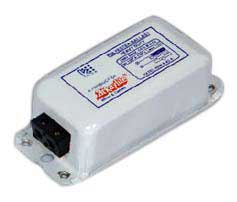
A fluorescent tube ballast is a device that regulates the current to a fluorescent lamp and provides the necessary voltage to start the lamp. Fluorescent lamps require a ballast to operate because they have negative resistance characteristics, meaning their resistance decreases as the current increases, which can lead to uncontrolled current flow and potential damage. The ballast ensures that the lamp starts correctly and operates efficiently.
Will Florescent light work without Ballast or Choke ?
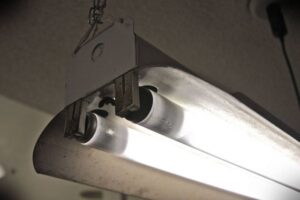
Fluorescent lights will not work without a ballast or choke. The ballast is essential for providing the initial high voltage surge needed to start the lamp by ionizing the gas within the tube and creating an arc between the electrodes. Additionally, once the lamp is started, the ballast regulates the current to prevent it from rising uncontrollably, which could lead to overheating, damage, and potential fire hazards. Without a ballast, the lamp cannot start properly and, even if it did, the lack of current regulation would result in unsafe and inefficient operation, ultimately shortening the lamp’s lifespan and posing significant safety risks.
Purpose of Starter in Magnetic ballast or choke
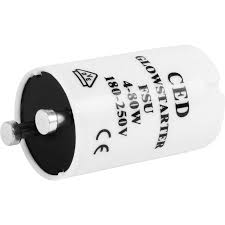
The purpose of the starter in a magnetic ballast or choke system is to help start the fluorescent lamp. When the light is turned on, the starter allows a small current to flow through the lamp’s electrodes, preheating them. After a short period, the starter opens its contacts, creating a high voltage surge from the ballast that ignites the lamp by ionizing the gas inside. Once the lamp is lit, the starter is no longer needed and remains open.
Types of Ballast
There are two main types of fluorescent tube ballasts: magnetic ballasts and electronic ballasts. Magnetic ballasts, also known as electromagnetic ballasts, are traditional and use a core and coil assembly to regulate current. Electronic ballasts, on the other hand, use electronic components like transistors and capacitors to control the current. They are lighter, more energy-efficient, and provide smoother operation with less flicker and noise compared to magnetic ballasts.
Magnetic Ballast

A magnetic ballast is a device used in fluorescent lighting systems to regulate the current and voltage supplied to the fluorescent bulb. It operates on the principle of electromagnetic induction to provide the necessary starting voltage and then regulates the current flow to sustain the ionization process within the bulb.
Working of Magnetic Ballast or Choke

- Starting the Lamp: When you turn on a fluorescent lamp, it needs a higher voltage to initiate the ionization of gas inside the tube. The magnetic ballast initially provides a higher voltage to start the lamp.
- Limiting Current: Once the lamp starts, the ballast regulates the current flowing through the lamp to prevent it from exceeding safe limits. This is crucial because fluorescent lamps require a stable current to maintain consistent light output.
Components of Magnetic Ballast or Choke.
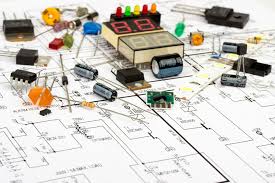
These are the main components of Magnetic Ballast or Choke
- Laminated Iron Core: This core is usually made up of thin sheets or laminations of iron. It provides a path for the magnetic flux generated by the coils and helps to concentrate the magnetic field.
- Coil Windings (Copper Windings): These are coils of insulated copper wire wound around the laminated iron core. The number of turns and the gauge of the wire determine the electrical characteristics of the ballast, such as voltage and current regulation.
- Capacitors: Capacitors are used in magnetic ballasts for power factor correction and to help control the current flowing through the lamp. They improve the efficiency of the ballast by reducing reactive power and improving the overall power factor of the system.
- Starter (in some designs): Some magnetic ballasts include a starter mechanism, which is a small, replaceable device used to initiate the ionization of gas within the fluorescent lamp at startup. The starter typically contains a small gas discharge tube or a bimetallic switch that helps create the initial high voltage needed to start the lamp.
- Wiring and Connectors: Magnetic ballasts include wiring and connectors to connect the ballast to the lamp and the power supply. These components ensure proper electrical connection and transfer of power to the lamp.
- Enclosure: Magnetic ballasts are usually housed in a protective metal or plastic enclosure. This enclosure provides mechanical support, protection from environmental factors, and insulation to prevent electrical hazards.
- Mounting Hardware: Depending on the design, magnetic ballasts may include mounting brackets or hardware to securely mount the ballast in a fixture or housing.
Advantages of Magnetic ballast or Choke

Here are some good advantages of Magnetic ballast.
- Reliability: Magnetic ballasts are known for their robustness and reliability. They have fewer electronic components compared to electronic ballasts, making them less prone to electronic failures.
- Cost-Effectiveness: In some cases, magnetic ballasts can be less expensive to manufacture than electronic ballasts, which can be advantageous for budget-conscious applications.
- Wide Voltage Tolerance: Magnetic ballasts typically have a wider voltage tolerance range compared to electronic ballasts. This can be beneficial in environments where voltage fluctuations are common.
- Compatibility: They are compatible with older fluorescent lamp types and can often be used as replacements in existing lighting fixtures without requiring modifications.
- Temperature Stability: Magnetic ballasts operate efficiently over a wide range of temperatures, making them suitable for applications where environmental conditions vary.
- Noise Levels: While they do produce a characteristic humming sound during operation, some users may find the sound less objectionable compared to certain types of electronic ballasts.
Disadvantages of Magnetic ballast or Choke

Here are some disadvantages of Magnetic chokes or ballast
- Energy Inefficiency: Magnetic ballasts are less energy-efficient compared to electronic ballasts. They consume more power and contribute to higher electricity bills over time.
- Heat Generation: Magnetic ballasts generate more heat during operation due to the electromagnetic processes involved. This heat not only reduces efficiency but also adds to the cooling requirements in lighting fixtures.
- Audible Humming: Magnetic ballasts are known to produce audible humming or buzzing sounds, especially as they age. This noise can be distracting in quiet environments and is considered undesirable in modern lighting installations.
- Bulk and Weight: Magnetic ballasts are larger and heavier than electronic ballasts, making them more cumbersome to install and handle. This increases shipping costs and may limit design flexibility in lighting fixtures.
- Limited Control Options: Magnetic ballasts offer limited control over lighting features compared to electronic ballasts. For instance, they may not support dimming or rapid-start capabilities, which are common features in electronic ballasts.
- Maintenance Requirements: They often require more frequent maintenance due to the wear and tear of components like starters and capacitors. This can lead to higher maintenance costs and downtime for lighting systems.
- Environmental Impact: Magnetic ballasts contain components such as copper, iron, and sometimes hazardous materials in capacitors. Disposal of these ballasts can pose environmental challenges due to the presence of these materials.
- Compatibility Issues: Magnetic ballasts may not be compatible with certain types of fluorescent lamps, especially newer energy-efficient models. This limits their usability in retrofitting or upgrading existing lighting systems.
Electronic Ballast
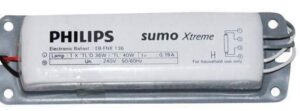
An electronic ballast is a device used in florescent lighting systems to regulate the current to fluorescent lamps and other gas-discharge lamps. It replaces the conventional magnetic ballast and starter in older lighting systems.
Working of Electronic Ballast

Here’s an easy-to-understand explanation on how Electronic ballast works :
- The electronic ballast receives an alternating current (AC) input from the power supply, typically 120V or 240V.
- This AC input is fed into a rectifier circuit, which converts it into direct current (DC). Rectifiers usually consist of diodes arranged in a bridge configuration to achieve this conversion.
- The rectified DC contains ripples (fluctuations in voltage). A filter circuit, typically comprising capacitors and inductors, smooths out these ripples to produce a stable DC voltage.
- The smooth DC voltage is then fed into an inverter circuit. The inverter, often made up of transistors or MOSFETs (metal-oxide-semiconductor field-effect transistors), converts the DC back into high-frequency AC. This high-frequency operation (typically 20 kHz to 60 kHz) is crucial for reducing flicker and improving efficiency.
- Starting the Lamp: The high-frequency AC is applied to the electrodes of the fluorescent lamp. The initial voltage is high to ionize the gas inside the lamp, creating a plasma state that initiates an electric arc between the electrodes. This process generates ultraviolet (UV) light.
- Phosphor Coating: The UV light produced by the arc interacts with the phosphor coating on the inside of the lamp’s glass, causing it to emit visible light.
- Current Regulation:A resonant circuit, consisting of inductors and capacitors, helps to control the voltage and current supplied to the lamp. This circuit ensures that the initial high voltage required to start the lamp is reduced once the lamp is running.
- Control Circuit: The control circuit monitors the current and voltage supplied to the lamp and adjusts the inverter’s operation to maintain optimal conditions. This feedback mechanism ensures stable operation, improving lamp life and efficiency.
Components of Electronic Ballast

An electronic fluorescent ballast typically consists of several key components designed to control and regulate the flow of electrical current through a fluorescent lamp. Here are the main components you would find in an electronic fluorescent ballast:
- MOSFET or IGBT Transistors: These are used as switches to convert the incoming AC voltage to high-frequency AC (often in the range of 20-60 kHz) that is needed to drive the fluorescent lamp. The switching action allows for efficient regulation of the current through the lamp.
- Resonant Capacitors and Inductors: These components form the resonant circuit that works together with the transistors to convert the voltage and regulate the current. They help in generating the high-frequency AC signal needed to operate the lamp.
- Diodes: Diodes are used for rectification and to convert the incoming AC voltage to DC voltage, which is then used to power the electronic circuitry within the ballast.
- Control IC (Integrated Circuit): Modern electronic ballasts often include a microcontroller or a specialized IC that controls the operation of the ballast. This IC regulates the frequency and voltage to ensure proper operation of the lamp and can incorporate features like dimming and protection functions.
- Start-up Circuit: This circuit initiates the lamp starting process, typically by providing a high voltage pulse to initiate ionization in the lamp tube. Once started, the ballast regulates the current flow to maintain stable operation.
- Filter Capacitors and Chokes: These components are used to filter out high-frequency noise generated during operation and ensure that the lamp operates efficiently without causing interference with other electronic devices.
- Heat Sink: Since electronic ballasts can generate heat due to switching losses, a heat sink is often included to dissipate heat and ensure the ballast operates within safe temperature limits.
- Protection Circuitry: Electronic ballasts may include protection features such as overcurrent protection, overvoltage protection, and thermal shutdown to prevent damage to the ballast and the connected lamp.
Advantages of Electronic ballast

Electronic fluorescent ballasts offer several advantages over traditional magnetic ballasts such as:
- Energy Efficiency: Electronic ballasts are more energy-efficient than magnetic ballasts. They operate at higher frequencies (typically 20-60 kHz) compared to the 60 Hz frequency of magnetic ballasts. This higher frequency operation reduces energy losses and improves overall efficiency.
- Improved Light Quality: Electronic ballasts eliminate the flickering associated with magnetic ballasts. They operate at frequencies high enough that the human eye cannot detect any flicker, resulting in steady, flicker-free light output.
- Dimming Capability: Electronic ballasts can be designed to support dimming functionalities, allowing for flexibility in lighting control. This is especially useful in environments where adjustable lighting levels are desired for different tasks or times of day.
- Compact Size and Lightweight: Electronic ballasts are typically smaller and lighter than magnetic ballasts. This makes them easier to install and allows for more flexible luminaire designs.
- Instant Start: Electronic ballasts provide instant starting of fluorescent lamps without any delay, unlike magnetic ballasts which may cause a noticeable delay before the lamp reaches full brightness.
- Noise Reduction: Electronic ballasts operate silently, as they do not produce the humming or buzzing sounds that can be associated with magnetic ballasts.
- Extended Lamp Life: The high-frequency operation of electronic ballasts can contribute to longer lamp life compared to magnetic ballasts. This is because the lamps experience less wear and stress during starting and operation.
Disadvantages of Electronic ballast

While electronic ballasts offer numerous advantages, they also come with a few disadvantages compared to traditional magnetic ballasts:
- Cost: Electronic ballasts tend to be more expensive than magnetic ballasts, primarily due to the complexity of their circuitry and components. This initial cost can be a deterrent for some consumers, especially in situations where upfront expenses are a concern.
- Compatibility Issues: Some electronic ballasts may have compatibility issues with older fluorescent lamps or specific types of lamps. It’s important to ensure compatibility between the ballast and the lamps being used to avoid performance issues or premature lamp failure.
- Reliability Concerns: Electronic ballasts rely on complex electronic components such as transistors, capacitors, and integrated circuits. While advancements in technology have improved reliability, electronic ballasts may still be more prone to failure compared to simpler magnetic ballasts, especially in harsh environmental conditions or if not properly ventilated.
- Electromagnetic Interference (EMI): Electronic ballasts can generate electromagnetic interference (EMI) due to their high-frequency operation. This interference can potentially disrupt nearby electronic devices or sensitive equipment, necessitating additional measures for EMI shielding or filtering.
- Environmental Impact: Electronic ballasts contain electronic components and circuitry that may include materials of environmental concern, such as certain metals or chemicals. Proper disposal or recycling of electronic ballasts is important to minimize environmental impact.
- Heat Generation: While electronic ballasts are generally more efficient than magnetic ballasts, they can still generate heat, especially during prolonged operation. Adequate heat dissipation is necessary in Fluorescent Ballast to prevent overheating and ensure longevity of the ballast and lamps.